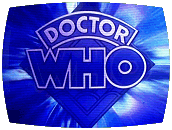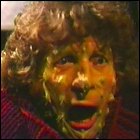 A power crisis in the underground habitat of the planet Tigella revives an age-old debate between science and religion. Tigella’s scientists want to examine their power source, the otherworldly Dodecahedron, more closely to see if it can help to avert the impending crisis that would force the Tigellans back to their planet’s uninhabitable surface. But the planet’s religious faction, led by Lexa, refuses to allow anyone access to the Dodecahedron, which they claim is a sacred relic. Zastor, Tigella’s leader, comes up with an unorthodox compromise: call for the Doctor’s help. But just as the TARDIS responds to the call, another plan is set into motion: Meglos, the last surviving member of the cactus-like Zolpha-Thuran race, has enlisted the aid of Gaztak pirates to take over the physical form of a hapless human. Once Meglos has this ability, he uses it to impersonate the Doctor, go to neighboring Tigella, and steal the Dodecahedron for himself. To ensure that the real Doctor doesn’t interfere with his plan, he traps the TARDIS in a chronic hysteresis – a time loop – from which the Doctor and Romana have to devise an ingenious escape. But by the time the real Time Lords arrive, the damage is done – the Dodecahedron is missing, and the Doctor is arrested for the gravest crime possible on Tigella.
A power crisis in the underground habitat of the planet Tigella revives an age-old debate between science and religion. Tigella’s scientists want to examine their power source, the otherworldly Dodecahedron, more closely to see if it can help to avert the impending crisis that would force the Tigellans back to their planet’s uninhabitable surface. But the planet’s religious faction, led by Lexa, refuses to allow anyone access to the Dodecahedron, which they claim is a sacred relic. Zastor, Tigella’s leader, comes up with an unorthodox compromise: call for the Doctor’s help. But just as the TARDIS responds to the call, another plan is set into motion: Meglos, the last surviving member of the cactus-like Zolpha-Thuran race, has enlisted the aid of Gaztak pirates to take over the physical form of a hapless human. Once Meglos has this ability, he uses it to impersonate the Doctor, go to neighboring Tigella, and steal the Dodecahedron for himself. To ensure that the real Doctor doesn’t interfere with his plan, he traps the TARDIS in a chronic hysteresis – a time loop – from which the Doctor and Romana have to devise an ingenious escape. But by the time the real Time Lords arrive, the damage is done – the Dodecahedron is missing, and the Doctor is arrested for the gravest crime possible on Tigella.
written by John Flanagan & Andrew McCulloch
directed by Terence Dudley
music by Peter Howell and Paddy KingslandGuest Cast: Edward Underdown (Zastor), Jacqueline Hill (Lexa), Crawford Logan (Deedrix), Colette Gleeson (Caris), Bill Fraser (Grugger), Frederick Treves (Brotadac), Simon Shaw (Tigellan Guard), Christopher Owen (Earthling)
Notes: This marks the only time that a former companion has returned to televised Doctor Who in a completely different role. Jacqueline Hill was one of the three original TARDIS travelers, Barbara Wright, in the earliest seasons of the series. Guest star Bill Fraser made himself infamous by claiming, during the publicity for Meglos, that he only took the part of General Grugger on the condition that he would get to kick K-9 onscreen. Apparently he was such a good adversary for the robot dog that he took on K-9 without the Doctor around to stop him in K-9 & Company.
Original Title: The Last Zolfa-Thuran
Broadcast from September 27 through October 18, 1980
LogBook entry & review by Earl Green
Review: The least effective story of Tom Baker’s final season by miles, Meglos is just a bit of a mess. It can’t decide if it’s going to be highly dramatic or completely silly a la season 17, and it seems to be humping the leg of The Hitchhiker’s Guide To The Galaxy the whole time, with the almost Monty Python-esque Gaztaks and their human prisoner who just wants to get home in time for tea. (The musical score, composed in part by Paddy Kingsland – who created music for Hitchhiker’s radio and TV incarnations – makes things even more obvious.) Somewhere in  here, one gets the impression that there was the vague germ of an idea about the ongoing struggle between religious fundamentalism and science, but that concept is quickly submerged by the end of part two and never manages to come up for air again.
here, one gets the impression that there was the vague germ of an idea about the ongoing struggle between religious fundamentalism and science, but that concept is quickly submerged by the end of part two and never manages to come up for air again.
Special effects-wise, though, Meglos tries new approaches to the execution of a completely virtual set. A new technique tried out on this episode, called “scene synch”, involved locking two motion-control cameras together: one focused on actors in an entirely blue-screened set, the other aimed at a miniature environment. Objects on the blue-screen set were built to match elements of the miniature model, so that actors could appear to step behind foreground objects, and the camera could move and follow the action and keep everything in proper perspective. This solves a lot of the problems that were so glaringly obvious with Underworld just a few seasons before, and while the technique wasn’t in use for long, some elements of it – namely a fully three-dimensional set painted blue to allow for the entire environment to be generated elsewhere – are still in use today. In retrospeect, it looks like actors blue-screened in on top of (or behind) miniatures, but it was a bold experiment for the time.
Jacqueline Hill became the first Doctor Who companion to return in another role here – actually, where the original series was concerned, she was the only actor to do so – and this character is very different from Barbara, though she’s not all that different from any other eye-rollingly over-the-top religious figure in this genre or any other. Still, she gives it her best here, and as with her original Doctor Who stint, she makes Lexa impossible to ignore or take lightly. In other companion news, K-9 – through a rushed repair job aboard the TARDIS – is reduced to two hours of action before he has to shut down and recharge, the latest instance of the robotic dog being gradually emasculated in usefulness to the show’s writers (per instructions from producer John Nathan-Turner).
For its other faults, Meglos may actually contain the most interesting verbal description of the Doctor that the original series ever produced: “He sees the threads that hold the universe together, and mends them when they break.”
Meglos isn’t a complete train wreck – there are pieces that are very entertaining – but those pieces add up to an uneven whole that really seems to belong more to the previous season than to this one.

